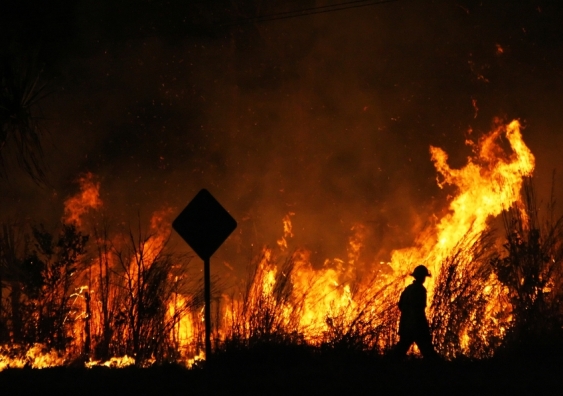BMP Fundamentals: Securing Your Residential Property Against Bushfire Risks
Wiki Article
The Relevance of Bushfire Monitoring in Fire Defense
In the world of fire security, the significance of efficient bushfire monitoring can not be underrated. As communities worldwide grapple with boosting circumstances of wildfires, the proactive strategy to protecting against and mitigating these all-natural calamities with tactical bushfire administration strategies has become a crucial element. Past the immediate hazard to human life and building, the interplay between bushfire management and eco-friendly preservation, neighborhood involvement, and environment adjustment postures complicated challenges that demand detailed solutions.Value of Proactive Bushfire Prevention
Positive bushfire avoidance strategies are necessary in minimizing the devastating impacts of wildfires on communities and ecosystems. One crucial element of proactive bushfire avoidance is gas monitoring.Informing the public on fire safety techniques and advertising community recognition regarding the importance of bushfire avoidance are vital parts of proactive techniques. Ultimately, aggressive bushfire prevention plays a substantial role in guarding communities and ecological communities from the devastating effects of wildfires.
Role of Neighborhood Engagement in Fire Security
Engaging the area in fire protection initiatives is integral to enhancing the efficiency of positive bushfire prevention strategies. Neighborhood involvement plays a vital function in promoting a cumulative understanding of the risks positioned by bushfires and the significance of preparedness measures. By involving regional citizens, authorities can disseminate essential information on fire safety and security practices, emptying procedures, and early caution systems, encouraging people to take aggressive actions to guard their residential properties and lives.In addition, area interaction campaigns aid develop strength within areas, fostering a feeling of unity and shared responsibility in mitigating fire threats. With workshops, training sessions, and area events, citizens can learn exactly how to produce defensible spaces around their homes, decrease fire gas lots, and identify potential dangers. By promoting a culture of preparedness and collaboration, areas can enhance their capability to respond properly to bushfire emergencies, lessening the influence on lives and residential or commercial properties. Eventually, area involvement is a foundation of comprehensive fire defense approaches, emphasizing the importance of cumulative action in guarding prone locations from the threat of bushfires.
Value of Wildlife Conservation in Bushfire Management
Preservation of wild animals plays an important function in efficient bushfire monitoring techniques, ensuring the defense of varied communities and biodiversity in fire-prone areas. Wildlife conservation is important as it adds to the overall durability of ecosystems, assisting in their ability to endure and recoup from the effect of bushfires. By preserving environments and shielding numerous varieties, the all-natural equilibrium within these environments is preserved, which is essential for their lasting health and wellness and sustainability.In addition, wildlife conservation also assists in minimizing the threat and intensity of bushfires. Healthy ecosystems with unspoiled wild animals populations can work as all-natural firebreaks, reducing the spread of fires and restricting their harmful capacity (BMP). Specific animal varieties, like burrowing animals or birds that spread out seeds, play distinct roles in helping or avoiding fires in the post-fire regrowth of environments
Integrating wild animals preservation right into bushfire monitoring strategies is not just crucial for securing biodiversity but also for advertising the total health and wellness and durability of communities despite increasing fire hazards.
Advantages of Strategic Fuel Decrease Programs
Purposefully carrying out gas decrease programs is necessary in reducing the threat and impact of bushfires in fire-prone regions. These programs include regulated burning, mechanical clearing up, BAL Assessment and other techniques to decrease the quantity of flammable greenery available to sustain wildfires. By strategically decreasing fuel lots in key locations, such as close to domestic neighborhoods or critical facilities, the strength and spread of bushfires can be significantly reduced.One of the primary benefits of fuel reduction programs is the improvement of general fire resilience in an ecosystem. By producing calculated gas breaks and reducing the continuity of plant life, these programs assist to disrupt the course of a bushfire, making it simpler for firemens to contain and extinguish the blaze. Furthermore, fuel decrease programs can shield biodiversity by stopping excessively intense fires that can ruin environments and endanger wild animals populations.
Moreover, these programs can likewise protect human lives and home by decreasing the risk of tragic fires that posture a considerable danger to communities. Inevitably, strategic gas decrease programs play a critical role in positive bushfire administration and fostering a safer atmosphere for both individuals and nature.
Influence of Climate Adjustment on Bushfire Threat

Greater temperatures cause drier plants, making it extra prone to ignition. Decreased rainfall in specific areas extends drought conditions, even more increasing the flammability of the landscape. Additionally, the changing environment has changed wind patterns and climatic conditions, resulting in more irregular fire habits and fast fire spread.
As the environment remains to transform, the frequency and strength of bushfires are expected to increase, necessitating a flexible and positive method to bushfire monitoring. Approaches need to progress to account for the changing threat landscape, incorporating climate forecasts and considering long-term durability in fire management preparation. Resolving the impact of climate change on bushfire danger is vital in establishing efficient approaches to secure lives, building, and the atmosphere.
Final Thought
Finally, positive bushfire prevention, community involvement, wildlife preservation, tactical gas decrease programs, and consideration of climate modification are crucial components in effective fire protection. By carrying out these techniques, we can better handle bushfire risks and safeguard both human lives and the setting. BAL Report. It is necessary that stakeholders function together to focus on these measures to minimize the terrible effect of bushfires on ecosystems and communities

As the climate continues to alter, the regularity and intensity of bushfires are expected to increase, necessitating a flexible and positive strategy to bushfire administration.In final thought, aggressive bushfire avoidance, community engagement, wildlife preservation, tactical fuel reduction programs, and consideration of climate change are vital parts in efficient fire protection.
Report this wiki page